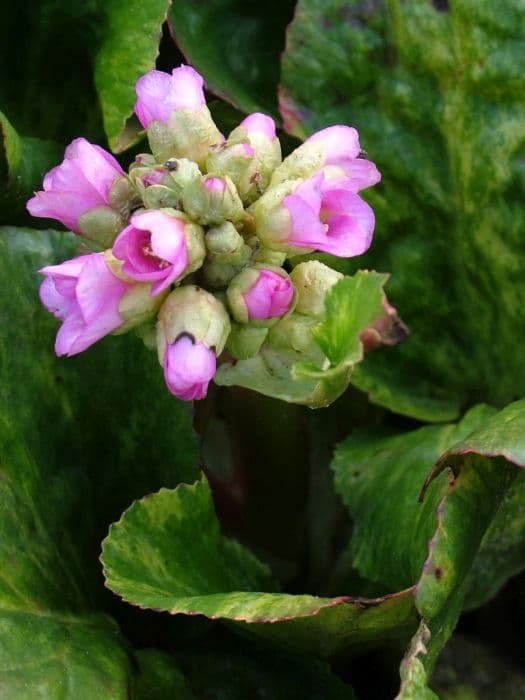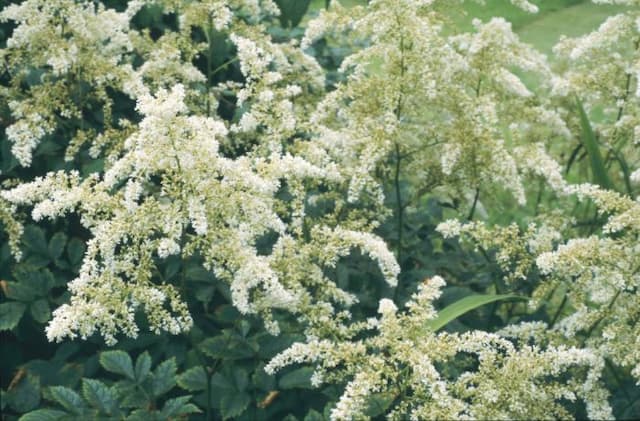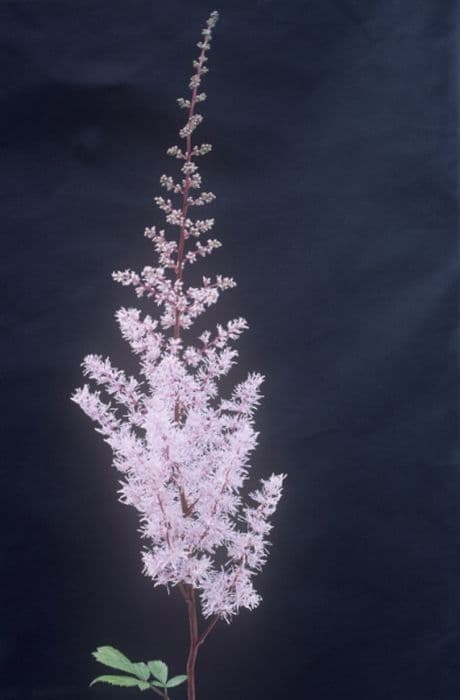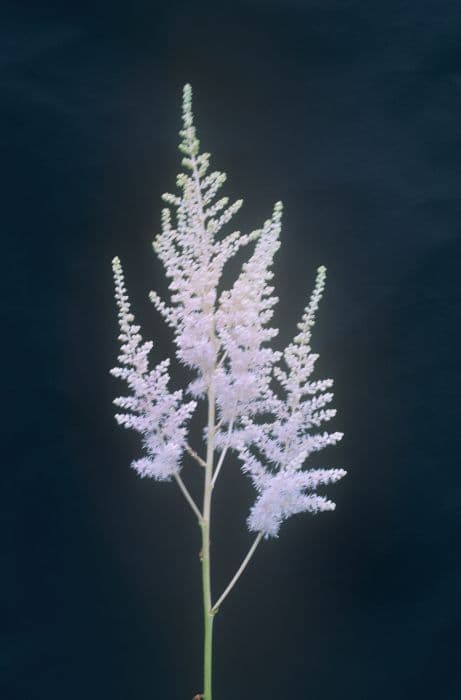Heartleaf Bergenia Bergenia cordifolia 'Tubby Andrews' (v)

ABOUT
Tubby Andrews is a perennial plant known for its distinctive foliage and flowers. This plant showcases broad, heart-shaped leaves that often have a glossy appearance. The color of the leaves is particularly noteworthy; they exhibit variegated patterns of green mixed with patches of cream, yellow or pink, giving them a striking and ornamental look that stands out in garden settings. During the blooming period, Tubby Andrews produces clusters of bell-shaped flowers held high above the foliage on sturdy stalks. These flowers are usually a soft pink to rose-red in color, adding to the visual interest of the plant. The foliage of Tubby Andrews may change as the seasons transition, with the leaves turning a rich bronze or red color in cooler weather, providing additional allure through the autumn months. The plant's overall appearance, with its colorful leaves and attractive flowers, makes it a popular choice for gardeners looking to add texture and color to their garden throughout different seasons.
About this plant
 Names
NamesFamily
Saxifragaceae
Synonyms
Heartleaf Bergenia, Elephant's Ears, Pig Squeak, Leather Bergenia, Winter Blooming Bergenia, Siberian Tea
Common names
Bergenia cordifolia 'Tubby Andrews'.
 Toxicity
ToxicityTo humans
Elephant's ears is not known to be toxic to humans. However, like with any plant, individuals may experience varying degrees of sensitivity. If symptoms appear following ingestion, it would be prudent to seek medical advice.
To pets
Elephant's ears is not generally considered toxic to pets. If a pet ingests a large quantity or shows signs of distress after chewing or consuming parts of this plant, it is recommended to consult with a veterinarian.
 Characteristics
CharacteristicsLife cycle
Perennials
Foliage type
Evergreen
Color of leaves
Variegated
Flower color
Pink
Height
1-2 feet (30-60 cm)
Spread
1-2 feet (30-60 cm)
Plant type
Herb
Hardiness zones
3-8
Native area
Asia
Benefits
 General Benefits
General Benefits- Attractive Flowers: Bergenia cordifolia 'Tubby Andrews' produces showy pink blooms that are aesthetically pleasing and can add color to gardens.
- Ground Cover: Its low-growing habit and broad leaves make it an excellent ground cover, effectively suppressing weeds and reducing garden maintenance.
- Tolerance of Various Soils: This plant adapts well to a variety of soil types, including clay, making it versatile for different garden conditions.
- Shade Tolerance: 'Tubby Andrews' can thrive in partial shade to full shade, which is beneficial for under-canopy planting and shaded garden areas.
- Seasonal Interest: With evergreen foliage in mild climates and seasonal changes in leaf color, it provides interest throughout the seasons.
- Drought Resistance: Once established, it has a degree of drought tolerance, reducing the need for frequent watering.
- Cold Hardy: The plant is cold-hardy, making it suitable for gardens in cooler climates withstanding winter temperatures.
- Low Maintenance: Requiring minimal care beyond the occasional tidying up, makes it a good choice for low-maintenance landscapes.
- Rabbit Resistant: Generally resistant to damage from rabbits, so it's less likely to be eaten in areas with wildlife.
- Pollinator Attraction: Bergenia cordifolia 'Tubby Andrews' can attract bees and other pollinators to the garden, supporting local ecosystems.
 Medical Properties
Medical Properties- This plant is not used for medical purposes.
 Air-purifying Qualities
Air-purifying QualitiesThis plant is not specifically known for air purifying qualities.
 Other Uses
Other Uses- As a natural dye: The leaves of Bergenia cordifolia can produce a range of dye colors depending on the mordant used, giving fabrics varied shades from greens to browns.
- In floral arrangements: The plant's bold foliage and pink flowers can be used in floral arrangements to add volume and a touch of color.
- As a ground cover: With its large, heart-shaped leaves, it serves as an effective ground cover, suppressing weeds and reducing soil erosion.
- In rock gardens: Due to its hardiness and low maintenance, it is often planted in rock gardens where it contrasts nicely with the rocky terrain.
- For seasonal interest: The leaves of Bergenia cordifolia change color in the autumn, adding seasonal interest to landscapes with their reddish-bronze hues.
- As edging plants: Their clumping nature and attractive foliage make them ideal for use as edging along paths or garden borders.
- In container gardens: They can thrive in containers, bringing their lush foliage and flowers to patios and balconies where ground planting isn't possible.
- To attract wildlife: The flowers of the Bergenia cordifolia provide nectar for bees and other pollinators, enhancing biodiversity.
- For winter gardens: It is one of the few plants that retain their leaves in winter, providing greenery in otherwise barren landscapes.
- To create garden themes: Used in Asian-themed gardens, the plant's foliage complements the aesthetics of minimalist and tranquil garden designs.
Interesting Facts
 Feng Shui
Feng ShuiThe plant Bergenia is not used in Feng Shui practice.
 Zodiac Sign Compitability
Zodiac Sign CompitabilityBergenia is not used in astrology practice.
 Plant Symbolism
Plant Symbolism- Adaptability - Bergenia, commonly known as Elephant's Ears due to the shape of its leaves, can thrive in various conditions, symbolizing the ability to adapt to different environments and situations.
- Endurance - Elephant's Ears are robust and can survive through tough winters, representing endurance and persistence through hardships.
- Protection - With its large leaves, the Elephant's Ears plant can provide shelter to smaller plants and organisms, hence symbolizing protection and care for others.
- Hardiness - As a plant that can withstand cold climates, Elephant's Ears signifies strength and resilience, capable of enduring challenges.
- Longevity - Bergenias are long-living perennials, which makes them a symbol of long life and lasting presence.
 Water
WaterElephant's Ears should be watered thoroughly, allowing the top inch of soil to dry out before watering again. During the growing season, this typically means watering once every week with approximately 1-2 gallons of water, depending on the size of the plant and the environmental conditions. Ensure that the pot has good drainage to prevent waterlogging, which can lead to root rot. In winter, reduce watering to every other week, but do not let the soil become completely dry.
 Light
LightElephant's Ears prefers partial shade to full shade conditions. It is best to place the plant in a spot where it can receive bright but indirect light, such as a location with filtered sunlight. Direct sunlight can scorch the leaves, so avoid placing it in full sun, especially in hotter climates.
 Temperature
TemperatureElephant's Ears thrives in temperatures ranging from 60 to 75 degrees Fahrenheit and can tolerate a minimum of 30 degrees Fahrenheit. The ideal temperatures help to promote healthy growth and bloom. Always protect the plant from frost and extreme heat by bringing it indoors or providing shade when temperatures exceed the ideal range.
 Pruning
PruningElephant's Ears can be pruned to remove dead or damaged leaves and to maintain a tidy appearance. Pruning is best done in the spring before new growth begins. Cut back any old foliage at the base to encourage new growth, and remove flower stalks after blooms have faded to direct the plant's energy into leaf production. Pruning can be done as needed throughout the growing season to keep the plant healthy and attractive.
 Cleaning
CleaningAs needed
 Soil
SoilElephant's Ears prefers moist, humus-rich soil with good drainage. The best soil mix for Elephant's Ears is one that combines garden soil, compost, and perlite or coarse sand to ensure drainage and fertility. They thrive in a soil pH range of 5.8 to 7.2, slightly acidic to neutral.
 Repotting
RepottingElephant's Ears don't require frequent repotting and can typically be repotted every 2 to 3 years. They are relatively slow growers, so repotting should be done when the plant has outgrown its current pot or the soil has deteriorated.
 Humidity & Misting
Humidity & MistingElephant's Ears prefers moderate to high humidity levels. They thrive best when the humidity is maintained around 40-60% which mimics their native woodland habitat.
 Suitable locations
Suitable locationsIndoor
Place in bright, indirect light and water when top soil dries.
Outdoor
Plant in part-shade, moist soil, protect from strong winds.
Hardiness zone
3-8 USDA
 Life cycle
Life cycleBergenia cordifolia 'Tubby Andrews', commonly known as Heartleaf Bergenia or 'Tubby Andrews' variety, initiates its life cycle when seeds germinate in moist, well-drained soils, typically in spring. Following germination, the seedling emerges and develops a rosette of heart-shaped, leathery leaves. As the plant matures, it forms clumps through vegetative propagation using its rhizomatous roots, which is often more common than reproduction by seed. 'Tubby Andrews' reaches maturity within a few years, displaying variegated leaves that are green with cream and pink splotches and producing pink flower spikes in the spring. After blooming, the seeds develop and are dispersed around the parent plant to start a new generation, although division of clumps is often used for propagation. Over its lifespan, which can be many years, 'Tubby Andrews' persists as an evergreen perennial in suitable climates, with foliage sometimes turning bronzy-red in the fall and winter.
 Propogation
PropogationPropogation time
Early Spring
Propogation: Bergenia cordifolia 'Tubby Andrews', often known as Heartleaf Bergenia or Elephant's Ears, is commonly propagated by division. The best time to carry out this method is in spring or after the plants have flowered. You divide the plant by carefully lifting it from the ground, using a sharp spade or knife. Then, separate the clumps into smaller sections, ensuring that each has at least one growing point or shoot. These divisions can then be immediately replanted into well-prepared soil, spacing them about 12 inches (approximately 30 centimeters) apart to allow for growth. Watering well after planting is crucial to help establish the new plants. This approach is favored as it is straightforward and typically results in robust plants that will start to flourish within the next growing season.









